What are protective sealants?
Protective sealant is also known as fissure sealant. A fissure sealant is a material that is placed in the pits and fissures of teeth to prevent the onset of caries or decay. It has also been used to arrest progression of early caries from small pits to cavitations. The sealant forms a protective layer that keeps food and bacteria from getting stuck in the tiny pits or fissures in the teeth and causing decay. It is a common preventative treatment for dentists to use for kids and is easily available at any dental clinic.
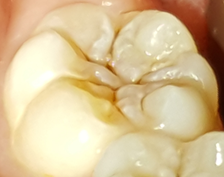 |
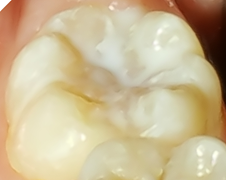 |
|
Before sealant |
After sealant |
Purpose of sealant
Dental decay or caries is an infectious oral disease that has a high incidence among children in our country. However, it is the most common preventable childhood infection that can be arrested in its early stages. About 90 percent of carious lesions are found in the pits and fissures of permanent molar teeth. Premolars and deciduous molars teeth too are also most susceptible to caries because their pits and fissures are often deep and winding. Plaque gets accumulated in these sites quite easily and are difficult to clean and get rid of.
The period where plaque gets easily accumulated in the mouth and teeth most susceptible to caries is during the eruption of the molars. The permanent molars take on average of 18 months to fully erupt into the mouth and thus, caries susceptible individuals required sealants to be applied at these teeth as soon as possible.
Currently the most available, cost effective and least invasive method to reduce caries on biting surface are pit and fissure sealants.
Who require sealant?
At-risk child and young people with
- Medical, physical or emotional impairment and who are at risk from dental disease or treatment
- Previous caries experience in primary teeth or other permanent molars
- High risk of getting caries – that is
- Children with fixed appliance therapy,
- Children with poor oral hygiene, irregular tooth brushing habit and brushes without assistance
- Children who has sugary intake more than 3 times in a day
Which tooth requires sealant?
- Teeth with very deep, narrow or complex pit or fissures
- Teeth with enamel (white layer of teeth) defect
- Primary and permanent teeth with susceptible pits and fissures in at-risk child
Types of protective sealants
The most common material used to seal pit or fissure seems to be resin-based (RB) or glass ionomer (GI) cement based. Adverse reactions or allergic response related to fissure sealant was found to be insignificant as its presence in the systemic circulation is not detectable.
The long-term success of pit and fissure sealants is directly related to their retention rate. Generally, the choice of sealant is based on stage of tooth eruption. Resin-based (RB) dental sealant is suitable for fully erupted tooth. Whereas, in partially erupted tooth, glass ionomer (GI) cement based is the best choice.
The literature review, has reported that, the data on the incidence of caries at 12 months of sealed teeth are very low, at around 2.5%. However, it is highly recommended the regular follow-up be done between 6 and 12 months.
Procedure
- Clean, dry and isolate the tooth from saliva
- Apply etching for 20 seconds(RB fissure sealant) or Apply conditioner for 15 seconds ( Gl cement based fissure sealant )
- Wash thoroughly with water
- Dry
- Apply sealant
- Cure with light(for RB fissure sealant) or Let it hardened for few minutes (for GI cement based fissure sealant)
- Monitor integrity of sealant at routine visits
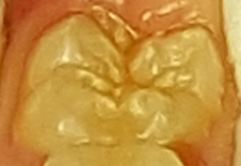 |
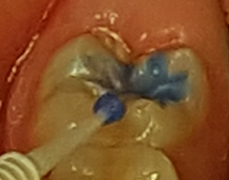 |
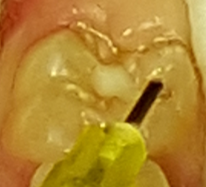 |
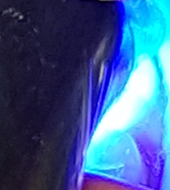 |
|
Clean, dry & isolate |
Etching |
Applying sealant |
Curing with light |
References
- Condo R, Cioffi A, Riccio A, et al: Sealants in dentistry: a Systematic review of the literature. Oral & Implantology – anno VI – n. 3/2013; 67-74.
- Beauchamp J, Caufield PW, Crall JJ, et al: Evidence-based clinical recommendations for the use of pit-and-fissure sealants. A report of the American Dental Association Council on Scientific Affairs. J Am Dent Assoc 2008; Mar;139(3):257-68.
- Muntean A, Mesaros AS, Festila D, Mesaros M.Modern management of dental decay in children and adolescents – a review. Clujul Medical 2015; 88(2):137-139.
- Small Ridge J. UK National Clinical Guidelines in Paediatric Dentistry. Use of fissure sealants including management of the stained fissure in first permanent molars. International Journal of Paediatric Dentistry 2010; 1-9.
- Welbury R, Raadal M, lygidakis N.A: EAPD guidelines for the use of pit and fissure sealants. European Journal of Paediatric Dentistry 3/2004; 179-184.
| Last Reviewed | : | 13 February 2017 |
| Writer | : | Dr. Norita bt. Abdul Rahim |
| Accreditor | : | Dr. Laila bt. Abd. Jalil |







